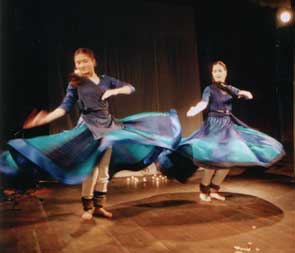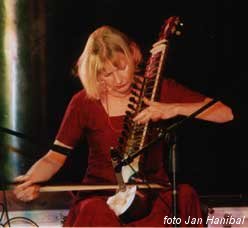Damaru - Kathak Dance & Live Indian Music
Ivana and Anezka Hessova - kathak dance
Elena Kubickova - esraj
Tomas Reindl - tabla, didjeridu, vocal part, realtime looping
 The group Damaru stems from the tradition of north Indian temple dance kathak which is delicately reshaped in a new creative manner. Experts consider kathak to be the only classical dance in which even the Indian artists can use new choreography. In one-hour long performance Damaru combines the world of dance and music. The traditional forms are supplemented by improvised panels, that originate from the group`s European background experience. Damaru has been built upon ancient principles of north Indian classical raags. The music part of the performance is enriched in some of its parts with several other instruments and colours (including dijeridu and aliquot singing).The group performed at Febiofest (International Film Festival in Prague, Day for India (UNICEF), accompanied Indian dancer Navian Jafa during her tour in Prague and is regularly performing all over Czech Republic.
The group Damaru stems from the tradition of north Indian temple dance kathak which is delicately reshaped in a new creative manner. Experts consider kathak to be the only classical dance in which even the Indian artists can use new choreography. In one-hour long performance Damaru combines the world of dance and music. The traditional forms are supplemented by improvised panels, that originate from the group`s European background experience. Damaru has been built upon ancient principles of north Indian classical raags. The music part of the performance is enriched in some of its parts with several other instruments and colours (including dijeridu and aliquot singing).The group performed at Febiofest (International Film Festival in Prague, Day for India (UNICEF), accompanied Indian dancer Navian Jafa during her tour in Prague and is regularly performing all over Czech Republic.
Damaru website.
Ivana Hessova
In 1992 she starts to work for Montreurs d`Images Theatre in Switzerland where she studies kathak dance, classical ceremonial dance from northern India, under the lead of a French professor Nathalie Rapallie. In 1992 she becomes a disciple of an Indian master of kathak Mata Prasad Mishra in Geneva, Switzerland. In 1997 she undertakes a study trip to India. In the next year she takes part as an actress and a dancer in Draupadí, a highly challenging performance focussing on a vedic myth Mahabharata launched by Montreurs d`Images Theatre together with Mr. M.P. Mishra. After completion of her Indian studies in February 2001 at guru Nirupama Rajendra in Bangalore (Lucknow Gharana) and in June 2001 at guru Mata Prasad Mishra in Benares (Baranas Gharana) she works as a stage director and a dancer on a performance entitled Indian Inspiration (see Taneční listy, volume 39, September 2002). Since 1995 she teaches Indian dance kathak, leads a dance studio and summer school project named New Encounters Mnichovo Hradiště. Since 1998 she performs together with her daughter, Anežka Hessová - a student of kathak at prof. M.P. Mishra and Nirupama Rajendra. With the Damaru she performed in the International Festival in Ferrara, Italy in 2004.
Elena Kubickova

studied classical violin under Gita Morenova, professor of the Prague Conservatory, after which she was a member of a string chamber orchestra for several years. She was educated in northern Indian classical music by violinist and musicologist prof. Dr. Smarajit Chakravorty, in India she studied under Dr. Jibendra Narayan Goswami (sitar maestro) and Dr. V. Balaji (singer and violinist, prof. of Hindu University in Benares). She has played the esraj since 1990. Together with other musicians she released several CDs of which several have been used as film music, for example for the three-part film by Igor Chaun "A Passage to India". She takes part in various festivals, e.g. Boskovice, Frýdek Místek, Lipnice, Alternativa (Theatre Archa), Febiofest (International film festival, Prague), One World (International documentary film festival, Prague) and has performed in Prague in a programme by the classical guitarist Lubomír Brabec at the Spanish synagogue. She has also appeared in Poland and Italy (International music Festival in Ferrara 2004). She collaborates with an important Czech tabla player Tomáš Reindl, Edward Powell, a Canadian sitar player living in Czech Republic and other musicians. The biggest honour for her is the collaboration with Dr. J. N. Goswami, with whom and his Indian tablaist she performed Jugalbandi in Prague (2005, 2006) and at the International Opera Festival Smetanova Litomysl in 2006. She regularly gives concerts of northern Indian classical music in many places of the Czech Republic. Elena also takes part in joint music-and-dance project DAMARU launched by Ivana Hessová, dancer and instructor of classical Indian dance kathak. For several years she has been preparing regular night programs of Indian classical music on the Czech National Radio Station "Vltava".
Tomas Reindl

studied the percussion in Pilsen Conservatory and later continued in private lessons at prof. Kympl (Conservatory of J.J.) and at jazz percussionist Ivan Audes. The basics of tabla music were disclosed to him by tablist Emil Heyrovský. In 2001 he travelled to Benares, India, to become a disciple of outstanding tablist and dancer Mata Prasad Mishra. He works with Kumura band as performer, display artist and composer (Festival of the Light of Rainbow 2000, performed with Iva Bitová in Boskovice 2000). He played the Indian classical music together with an esraj player Elena Kubičková. Since 2000 he has been cooperating with a dancer and choreographer Ivana Hessová, the author of dramatic project Indian Inspiration, in which he was involved as a musician and display artist. During the summer workshops "New Encounters in the New Century" in Mnichovo Hradiště, he participates as an instructor of rythmic studio. As an externist he has collaborated with the Faculty of Humanities (Charles University, Prague) on a Certified Programme of Ethnomusicology called "Collegium Ethnomusicologicum".
Indian Classical Music
The vocal and instrumental north Indian classical music is based on ragas and talas. Melodic structure, rules for using microtones and ornaments are determined by raga (there are several hundred of known ragas), rythmic cycles are set by tala.
Esraj is a traditional Indian string instrument. It has 19 strings consisting of 4 main strings. The rest is formed into two octaves of resonant strings tuned into given gamut.
Tabla is a set of two drums. The drum on the right side is called dayan and is tuned in the key tonic. The left-side drum is called bayan and is tuned into bass.
Indian Classical Dance
Brief History:
Indian classical dance was originally performed in temples as an evocation and thank offering to gods. However, during the rule of Mughal Dynasty the dance in the temples is forbidden and moves to the palaces of the Rajas. The literary contents is supressed in favour of mastering pure technique. Nevertheless, Hindi myths and legends are preserved in their narrative parts. Traditional dance is performed by one dancer, who is rather a story teller. Present day kathak is a very advanced art. It has undergone important changes in its forms and expressions. The dancers themselves contributed greatly to its development with their own modern artistic choreographies.
Technique:
The technique of kathak is based primarily on the choreography speech, demonstrated by mudras (hand gestures), rythmic motions of legs, facial expressions and figurative body positions. The legs move in accordance to a set of complex rythmic patterns. In addition, there are small jinglebells (ghungaru) attached to both of dancer`s legs. Their sound, when the feet hit the floor, is admiringly syncronized with gesture positions of the upper part of the body. Strong emphasis is put especially on pirouettes and jumps accompanied by the beat of drums called tabla. The teacher leads the disciple to virtuosity in all syntactic parts of the dance.
Contents:
The technique of kathak is based primarily on the choreography speech, demonstrated by mudras (hand gestures), rythmic motions of legs, facial expressions and figurative body positions. The legs move in accordance to a set of complex rythmic patterns. In addition, there are small jinglebells (ghungaru) attached to both of dancer`s legs. Their sound, when the feet hit the floor, is admiringly syncronized with gesture positions of the upper part of the body. Strong emphasis is put especially on pirouettes and jumps accompanied by the beat of drums called tabla. The teacher leads the disciple to virtuosity in all syntactic parts of the dance.

